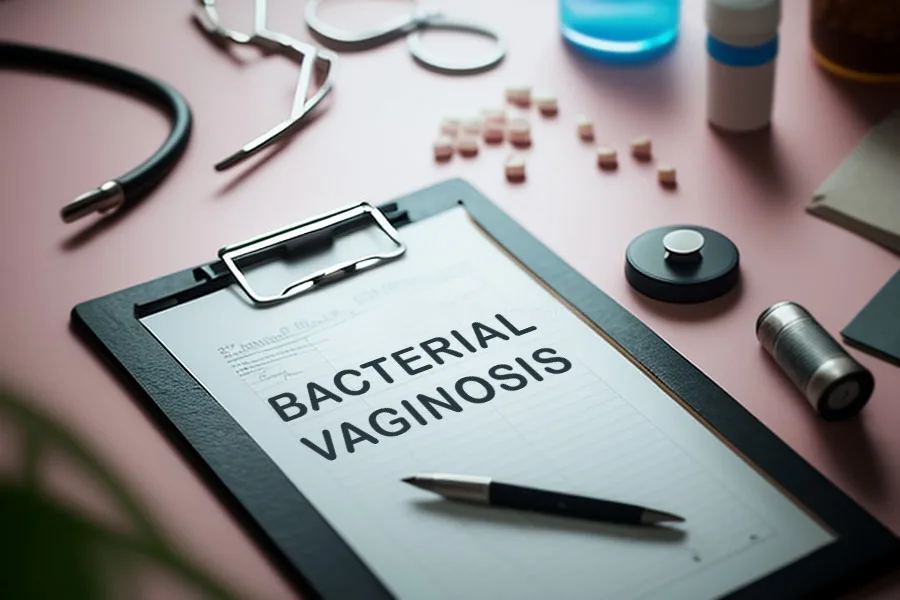The scientific evidence shows that women with bacterial vaginosis (BV) are prevalent in patients with infertility. A study from 2013 estimates that the prevalence of patients who have BV is 19% and abnormal vaginal flora occurs in 39% of infertile patients. In this article, we cover the mechanism of how BV affects fertility and what options women of reproductive age have to keep their ability to have a child.
The definition of BV
Bacterial vaginosis, or BV for short, is one of the most prevalent vaginal infections. In the US, almost every third woman has been affected by it. This health issue can develop when the balance in a vaginal microbiome becomes unstable.
Your vaginal flora contains lactobacilli—beneficial microorganisms that produce lactic acid. Lactic acid makes your vaginal PH acidic which is hostile to harmful bacteria and, thus, keeps their proliferation at bay. If the number of lactobacilli is reduced, it cannot stop the growth of infection.
It should be remembered that women with BV may not feel any symptoms, but, if present, these symptoms can be a signal of bacterial-caused vaginosis:
- the discharge from a vagina has unusual milky-white or grayish color;
- an unpleasant fishlike odor occurs;
- irritation, redness, and itching located in the vagina;
- disuria (burning sensation when urinating).
BV vs fertility
BV is a significant risk factor that can seriously affect the ability to conceive a child in several different ways starting from the changes in the vagina condition to potentially dangerous complications when untreated.
First of all, a growing infection creates inflammation, temperature and PH changes in the vagina; it also triggers the activity of the immune system which is not a positive environment for sperm to survive. BV also impairs the production of healthy cervical mucus during ovulation that is intended to help sperm to reach the egg and fertilize it. Neglected infection can damage the tissues of the vagina and fallopian tubes which contributes to sperm’s inability to get to the egg.
When left unchecked for a long time, bacterial vaginosis can lead to PID which is an abbreviation of pelvic inflammatory disease. It damages the fallopian tubes making them scarred and impassable which means infertility. The patient also becomes more prone to sexually transmitted diseases, such as gonorrhea and chlamydiosis, that are also known to be able to cause infertility.
BV and carrying a child
For pregnant women, BV can create a double increase in the risk of losing the baby conceived with IVF. Besides that, having a vaginal infection increases the risk of miscarriages, preterm birth, and low birth weight.
BV, STDs, and yeast infection: the difference
Being an infection, bacterial vaginosis does not belong to sexually transmitted infections and can affect any reproductive-aged woman even when she has no sexual activity. In fact, vaginal flora with a potential development into BV can be caused by many factors, both related and unrelated to sexual intercourse:
- Being sexually active. Male sperm has an alkaline PH which opposes an acidic environment created by lactobacilli in the vagina. As a result, vaginal PH can change and become more positive for the growth of harmful infections. Having a new partner, especially when you are not practicing using condoms, can also contribute to disbalance in your microbiome. Women can transmit an infection from one to the other during petting.
- The use of the UID (intrauterine devices used for contraception) is associated with a higher risk of developing bacterial vaginosis. The main suggested reason is that a UID is essentially a foreign body for your organism and it does tend to get heavily contaminated with bacteria.
- The use of aggressive hygienic and cosmetic products for or around your vagina that can change your vaginal flora.
The yeast infection, aka candidiasis, while similar in terms of the triggering factors, differs from BV in symptoms, pathogen, and treatment.
Symptoms differences
While BV can proceed hidden, yeast infection is hard to miss. And if bacterial vaginosis does have symptomatic, it differs:
- BV is caused by bacteria overgrowth, and candidiasis’ pathogen agent is a fungus called Candida.
- BV causes a fishlike smell and yeast infection has no distinctive odor.
- Vaginal discharge during yeast infection has a consistency of cottage cheese, while with BV it is milkier.
- The sensation when urinating if having BV is burning while with candidiasis it is just painful.
- Bacterial vaginosis is treated with antibiotics, and for yeast infection, your OB-GYN will prescribe antifungal treatment.
Treatment options
As we said, the best option to treat BV is antibiotics. The ACOG guidelines regarding bacterial vaginosis recommend administering oral or intravaginal antibiotical medications and, if needed, their combinations. The medications can come in pills, capsules, creams, gels, and ovules. The most common drugs used for BV are Metronidazole, Clindamycin, Secnidazole, and Tinidazole. It is recommended to restrict your sexual activity while getting treatment and if you have a constant sexual female partner they may need treatment, too.
Since antibiotics destroy all the bacteria, not only the harmful ones, the problem of microflora disbalance remains making patients still prone to recurrent. To avoid this, ask your doctor about recovering your healthy vaginal flora-—they can recommend you proper supplements with the micronutrients required for getting your good microbiota back in shape.
Prophylactics
The key to your vaginal health is moderation and simplicity:
- Avoid using products for your hygienic procedures: plain warm water does a great job of keeping your vagina clean and healthy. Soap, douching gels, deodorants, and other products can wash out all your lactobacilli and harm your vaginal PH balance. It applies not only to chemical substances but also to some components marketed as natural and safe.
- Staying hydrated during the day helps your immune system in getting harmful bacteria out.
- Wholesome balanced diet provides nutrients that your lactobacilli need to thrive.
- Regular check-ups at your medical center or sexual health clinic and honest communication with your doctor allow you to prevent an infection or catch it at its early stage.
Summary
Bacterial vaginosis is a common but hard-to-catch infection that can cause some serious health troubles. When neglected, it leads to dangerous complications, such as PID, infertility, pregnancy loss, and birth defects. The good news is that this infection can be easily treated even during pregnancy so you do not have to worry if being diagnosed.
To get treated in time and avoid much discomfort and complications, have regular and open conversations with your OB-GYN about your health, and do not hesitate to ask questions or tell them about any changes that concern you. Having a healthy lifestyle and using mechanical protection during sex can significantly reduce your risks of developing BV.




